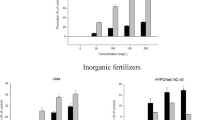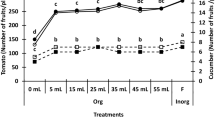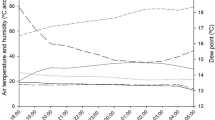Abstract
Cucumber (Cucumis sativus L.) production needs moderately low quantity of nitrogen (N) and higher amount of phosphorus (P) and potassium (K). Cucumbers produce quality fruits in soils where N, P and K ratio are moderately equal. Cucumber production under high tunnels with same ratio of nutrients application may enhance profitability and productivity. Experiments were undertaken in high tunnels to evaluate crop efficiency, productivity and nutritional content. In this experiment, the cucumber cultivar Rohini-F1 was used as test crop. N, P and K fertilizers were administered at the rates of 70N:80P:70K kg ha−1 at 0 (F0, fertilization once during seedbed preparation) and at 15 (F1), 30 (F2), and 45 (F3) day intervals with complete dose application. After each 30 day interval, F2 had the highest marketable yield. F1 produced high-quality fruits with Grade‑A, followed by F2 and F3, while F0 produced fruits with Grade‑C. F2 had the largest cucumber density, F0 had the highest moisture percentage, F2 had the highest chlorophyll content in leaves, and F1, F2, and F3 had the longest shelf-life, all of which were larger than F0. The F1 interval had the greatest levels of N, P, and K in fruit of all treatments. F1 had the highest level of N in the vines, whereas F2 had the highest level of P and K. Total NPK uptake was as follows: F1 > F2 > F3 > F0.
Zusammenfassung
Der Anbau von Gurken (Cucumis sativus L.) erfordert eine relativ geringe Menge an Stickstoff (N) und eine höhere Menge an Phosphor (P) und Kalium (K). Gurken produzieren hochwertige Früchte in Böden, in denen das Verhältnis von N, P und K ungefähr ausgeglichen ist. Der Gurkenanbau in Hochtunneln mit gleichem Nährstoffeinsatzverhältnis kann die Rentabilität und Produktivität steigern. Es wurden Versuche in Hochtunneln durchgeführt, um die Effizienz, die Produktivität und den Nährstoffgehalt der Kulturen zu bewerten. In diesem Versuch wurde die Gurkensorte Rohini-F1 als Testpflanze verwendet. N‑, P‑ und K‑Düngemittel wurden in einer Dosierung von 70 N :80 P :70 K kg ha−1 zu Beginn (F0, einmalige Düngung während der Saatbettbereitung) und in Abständen von 15 (F1), 30 (F2) und 45 (F3) Tagen bei vollständiger Dosierung verabreicht. Nach jedem 30-Tage-Intervall wies F2 den höchsten marktfähigen Ertrag auf. F1 produzierte hochwertige Früchte der Güteklasse A, gefolgt von F2 und F3, während F0 Früchte der Güteklasse C produzierte. F2 wies die größte Gurkendichte auf, F0 den höchsten Feuchtigkeitsgehalt, F2 den höchsten Chlorophyllgehalt in den Blättern und F1, F2 und F3 die längste Haltbarkeit, die alle größer waren als F0. F1 wies von allen Behandlungen die höchsten Gehalte an N, P und K in den Früchten auf. F1 hatte den höchsten N‑Gehalt in den Reben, während F2 den höchsten P‑ und K‑Gehalt aufwies. Die Gesamt-NPK-Aufnahme war wie folgt: F1 > F2 > F3 > F0.








Similar content being viewed by others
References
Agarwal S, Rao A (2000) Tomato lycopene and its role in human health and chronic diseases. CMAJ 163(6):739–744
Agrawal RS, Ghadage SR, Mane KA, Pawar VN (2010) Tomato lycopene: Potential health benefits. The Pharma Innovation Journal 8(6):1245–1248
Antignus Y, Lapidot M, Mor N, Ben-Joseph R, Cohen S (1996) Ultra violet absorbing plastic sheets protect crops from insect pests and virus diseases vectored by insects. Environ Entomol 25:919–924
Ayeni LS (2010) Effect of poultry manure on soil physico-chemical properties, leaf nutrient contents and yield of yam (Dioscorea rotundata) on alfisol in southwestern Nigeria. Journal of American science 6(10):871–878
Balemi T (2008) Response of tomato cultivars differing in growth habit to nitrogen and phosphorus fertilizers and spacing on vertisol in Ethiopia. Acta Agriculturae Slovenica 91(1):103–119
Both AJ, Reiss E, Sudal JF, Holmstrom KE, Wyenandt CA, Kline WL, Garrison SA (2007) Evaluation of a manual energy curtain for tomato production in high tunnels. Hort Technol 17:467–472
Bremmer JM, Mulvaney CS (1982) Nitrogen total. In: Page AL, Miller MH, Keeney DR (eds) Methods of soil analysis. Part‑2, 2nd edn. Am. Soc. Agron., Madison, pp 903–948
Carey EE, Jett L, Lamont WJ Jr., Nennich TT, Orzolek MD, Wereiams KA (2009) Horticultural crop production in high tunnels in the United States: A snapshot. Hort Technol 19(1):37–43
Chaudhry FA, Reimer RJ, Bellocchio EE, Danbolt NC, Osen KK, Edwards RH, Storm-Mathisen J (1998) The vesicular GABA transporter, VGAT, localizes to synaptic vesicles in sets of glycinergic as well as GABAergic neurons. Journal of Neuroscience 18(23):9733–9750
Costa HS, Robb KL, Wilen CA (2002) Field trials measuring the effects of ultraviolet-absorbing greenhouse plastic films on insect populations. J Econ Entomol 95:113–120
Dorais M, Allaire S, Caron J, Menard C (2001) Growing media varying in particle size and shape for greenhouse tomato. In International Symposium on Growing Media and Hydroponics 644:307–311
Dufour L, Guérin V (2005) Nutrient solution effects on the development and yield of Anthurium andreanum Lind. in tropical soilless conditions. Scientia Horticulturae 105(2):269–282
Fontes NA, Faturi C, Ezequiel JMB, Stiaque MG (2006) Fibra solúvel e amido como fontes de carboidratos para terminação de novilhos em confinamento. Revista Brasileira de Zootecnia 35(5):2110–2117
Hussain SG, Karim Z, Ahmed M (1990) Salinity problems and crop intensification in the coastal regions of Bangladesh. Bangladesh Agricultural Research Council
Ibrahim KH, Fadni OAS (2013) Effect of organic fertilizers application on growth, yield and quality of tomatoes in North Kordofan (sandy soil) western Sudan. Greener Journal of Agricultural Sciences 3(4):299–304.
Ilyas M, Ayub G, Imran, Ali Awan A, Ahmad M (2020) Effect of calcium and boron on production and quality of autumn potato under chilling temperature. Commun Soil Sci Plant Anal. https://doi.org/10.1080/00103624.2020.1854286
Imran (2021) The bioavailability of phosphorus in composite vs. hybrid maize differ with phosphorus and boron fertilization. Phosphorus Sulfur Silicon Relat Elem. https://doi.org/10.1080/10426507.2021.1920588
Imran, Amanullah (2021) Phosphorus and boron application optimizing biofortification of phosphorus and productivity of French Bean (Phaseolus vulgaris L.). Commun Soil Sci Plant Anal. https://doi.org/10.1080/10426507.2021.105828
Imran A, Al Tawaha AR (2021b) Carbon assimilation and dry matter partitioning in Soybean ameliorates with the integration of nano-black carbon, along with beneficial microbes and phosphorus fertilization. J Plant Nutr. https://doi.org/10.1080/10426507.2021.19205
Imran A, Al Tawaha ARM (2021a) Management of nano-black carbon, phosphorous and bio-fertilizer improve soil organic carbon and ensilage biomass of soybean and maize. Commun Soil Sci Plant Anal. https://doi.org/10.1080/00103624.2021.1966439
Imran A, Al-Tawaha AR (2020) The productivity of subsequent wheat enhanced with residual carbon sources and phosphorus under improved irrigation system. Commun Soil Sci Plant Anal. https://doi.org/10.1080/00103624.2020.1763387
Imran A, Ali Khan A, Mahmood T, Al Tawaha AR, Khanum S (2021) Adequate fertilization, application method and sowing techniques improve Maize yield and related traits. Commun Soil Sci Plant Anal. https://doi.org/10.1080/00103624.2021.1925688
Javaria S, Khan MQ, Bakhsh I (2012) Effect of potassium on chemical and sensory attributes of tomato fruit. The journal of animal & plant sciences 22(4):1081–1085
Khokhar S, Magnusdottir SGM (2002) Total phenol, catechin, and caffeine contents of teas commonly consumed in the United Kingdom. Journal of agricultural and food chemistry 50(3):565–570
Kue S (1996) Phosphorus. In: Spark DL (ed) Method of soil analysis part 3. Chemical methods. SSSA, ASA, Madison, pp 869–919
Kurata K (1992) Two dimensional analysis of irradiance disturbance at canopy foliage in relation to diffusivity of films of plastic houses. Acta Hortic 303:113–120
Lamont WJ (2009) Overview of the use of high tunnels worldwide. Hort Technol 19:25–36
Lamont WJ, Orzolek MD, Holcomb EJ, Demchak K, Burkhart E, White L, Dye B (2003) Production system for horticultural crops grown in the Penn State high tunnel. Hort Technol 13:358–362
Maynard DN, Hochmuth GJ (1997) Knott’s handbook for vegetable growers, 4th edn., pp 91–93, 147
Mclean EO (1983) Soil pH and lime requirement p. In: Spark DL (ed) Methods of soil analysis: part 2, chemical and microbiological properties. Soil Science Society of America, and American Society of Agronomy, Madison, WI
Mehla CP, Srivastava VK, Jage S, Mangat R, Singh J, Ram M (2000) Response of tomato varities to N and P fertilization and spacing. Ind J Agric Res 34(3):182–184
Mills DJ, Coffman CB, Teasdale JR, Everts KL, Anderson JD (2002) Factors associated with foliar disease of staked fresh market tomatoes grown under differing bed strategies. Plant Dis 86:356–361
MINFAL (2011) Agricultural statistics of Pakistan. Ministry of Food, Agriculture, and Livestock. Food, Agriculture, and Livestock Division (Economic Wing), Islamabad
Nelson DW, Sommers L (1983) Total carbon, organic carbon, and organic matter. In: Spark DL (ed) Methods of soil analysis: part 2, chemical and microbiological properties. Soil Science Society of America, and American Society of Agronomy, Madison, WI
Olaniyi JO, Ajibola AT (2008) Effects of inorganic and organic fertilizers application on the growth, fruit yield and quality of tomato (Lycopersicon lycopersicum). Journal of Applied Biosciences 8(1):236–242
Orzolek MD, Lamont WJ, White L (2004) Promising horticultural crops for production in high tunnels in the mid-Atlantic area of the United States. Acta Hortic 633:453–458
Pandey RP, Solanki PN, Saraf RK, Parihar MS (1996) Effect of Nitrogen and Phosphorus on growth and yield of tomato varieties. Punjab Veg Grow 31:1–5
Radzevicius A, Karklelienė R, Viskelis P, Bobinas C, Bobinaitė R, Sakalauskienė SS (2009) Tomato (Lycopersicon esculentum Mill.) fruit quality and physiological parameters at different ripening stages of; Lithuanian cultivars. Agron Res 7(Special issue II):712–718
Saunyama IGM, Knapp M (2003) Effect of pruning and trellising of tomatoes on red spider mite incidence and crop yield in Zimbabwe. Afr Crop Sci J 11(4):269–277
Shibli RA, Sawwan J, Swaidat I, Tahat M (1995) Phosphorus regulates osmotic potential and growth of African violet under in vitro-induced water deficit. Journal of plant nutrition 23(6):759–771
Soltanpour PN, Schwab AP (1977) A new soil test for simultaneous extraction of macro and micro nutrients in alkaline soils. Commun Soil Sci Plant Anal 8:195–207
Steel RGD, Terrie JH (1996) Principles and procedures of statistics: A biometrical approach. 2nd ed. McGraw-Hill, New York
Wittwer SH (1993) World-wide use of plastics in horticultural production. Hort Technol 3:6–19
Xiao CL, Chandler CK, Price JF, Duval JR, Mertely JC, Legard DE (2001) Comparison of epidemics of Botrytis fruit rot and powdery mildew of strawberry in large plastic tunnel and field production systems. Plant Dis 85:90–909
Author information
Authors and Affiliations
Corresponding author
Ethics declarations
Conflict of interest
Imran, Amanullah and Ibrahim Ortas declare that they have no competing interests.
Rights and permissions
About this article
Cite this article
Imran, Amanullah & Ibrahim Ortas Agronomic Practices Improved Cucumber Productivity, Nutrients Uptake and Quality. Gesunde Pflanzen 74, 595–602 (2022). https://doi.org/10.1007/s10343-022-00634-1
Received:
Accepted:
Published:
Issue Date:
DOI: https://doi.org/10.1007/s10343-022-00634-1




